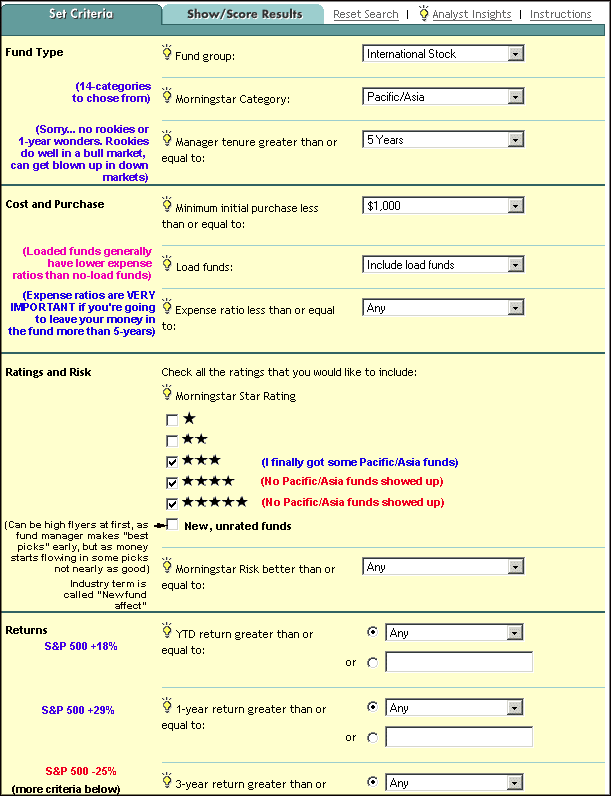Compare Mutual Funds Investor Intelligence at Morningstar
Post on: 23 Июнь, 2015 No Comment

SECTIONS
Morningstar is probably the most popular, informative and user-friendly survey of mutual fund performance. They provide independent investment research on 13,000+ funds, including in-depth commentary and analysis on more than 2,000 of them.
Their free membership offers:
- Financial data on 13,000+ funds and 7,000+ stocks, including their star rating
- Tools for screening. and portfolio management & analysis
- An extensive archive of articles
- Full access to discussion boards
- Investing courses with online tests, where good results are rewarded with Morningstar merchandise
Premium members also get:
- In-depth analysis on 2,000+ mutual funds & ETFs. as well as 2000+ stocks
- Stewardship grades for stocks and funds
- Enhanced tools
- Picks & Pans eNewsletters
- Discounts on Morningstar merchandise

Morningstar’s Star-Rating System
They reflect how each fund did compared to similar ones, which gives a hint on how cost-effective and well-managed it is, in relation to the rest in its class
One of the better-known tools offered by Morningstar to aid fund comparison is their five-star rating system. This is a quantitative measure of relative performance, taking risk and sales charges into account. To put that in other words, what they show is how well each fund did compared to the rest in their class, on the basis of their total returns after discounting sales charges, loads and redemption fees, and including a penalty if the fund experienced larger price fluctuations, in average, than its alternatives (or a plus if it suffered smaller ones). Bear in mind that the volatility of the returns of an investment (meaning the size of its fluctuations, daily or otherwise, in a kind of average) is considered a measure of its risk ; therefore, that penalty or premium is what they call risk adjustment .
Being a relative measurement between 1 and 5, the average mark is 3 stars. 35% of the funds obtain that rating, while 22.5% get 4 stars, and 10% get 5.
It is important to remember is that this is a measurement of past performance which, as it is always said, is not a reliable indicator of future performance. For example, if a fund returned 15% last year, it would be a wild guess to say that it will perform as well on this and the following years. But Morningstar’s ratings reflect a different thing, that is somewhat more useful to compare mutual funds. As we said before, they indicate relative returns. That data is not (too much) influenced by the erratic performance of the asset class, because it represents how well each fund performed compared to similar ones. Such a measure gives a hint on how cost-effective and well-managed the fund has been, in relation to the rest in its category. More so considering that this evaluation is not just a plain comparison of returns, but one that puts costs and assumed risk in the equation.
Nevertheless, this rating gives no more than a hint, because neither in relative terms is past performance a guarantee of future results. A good star ranking can be the result of some lucky stock or bond picks that will not be repeated in the future. What’s more, efficient-market-hypothesis advocates will say that luck has to be the reason for such outperformance. Besides, funds may belong to the same category but target assets that are, on a small scale, of a different kind. Therefore, a mutual fund may obtain a high rating because of outperforming others that are considered to be almost equal, when it was actually an apple among oranges. The bottom line is that the star rating shouldn’t be considered a definitive indicator, nor a buy or sell signal .
Stewardship Grades
The Morningstar Stewardship Grade (previously called Fiduciary Grade ) complements the Star Rating by factoring in some intangibles not considered there, related to mutual fund governance and operations. These grades, which range from A (best) to F (worst), assess key factors according to a systematic evaluation performed by Morningstar’s analysts. who study and assign a score to each of the following five components: regulatory issues, board quality, manager incentives, fees, and corporate culture. Fund reports at Mornigstar inform the scores for each of the five components, as well as the final result.
Investing Classroom
Up-to-the-point online courses are offered for free, covering four subject areas: stocks, bonds, funds and portfolio management. Each area has a separate curriculum, consisting of ordered modules, each module ending with a multiple-choice test. Correct answers award points which can be exchanged for merchandise; a 6-month premium membership, for example. The courses can be followed at your own pace, you can even retake the tests if you feel you hurried into them. The classes are mostly easy-to-read tutorials organized as series of brief pages, with frequent use of bulleted lists and recaps. This is good study material to complement with other readings and to enable further self-learning.
Select and Compare Funds
To find and compare mutual funds, you can use the advanced fund screeners offered by Morningstar. The one that is included with their free subscription is handy for listing funds according to 18 criteria, such as category, manager tenure, minimum initial purchase, load or no-load, expense ratio, star rating, past performance, turnover, and basic portfolio composition. Premium members have access to a more-detailed screener. There are also fund compare and similar funds tools, as well as exchange-traded-fund (ETF) screeners for free and premium members.
Portfolio Management and Analysis Tools
User-friendly advanced tools for portfolio analysis and follow-up are offered to free members, with enhanced versions for premium ones. Key data related to portfolio diversification and performance can be visualized clearly, with easy access to benchmark comparisons and automated suggestions for improvement.
Morningstar also carries special research reports on major fund families like Fidelity, American Fund and Vanguard. For these and other reasons it is a popular resource for investors wanting to compare mutual funds to make informed decisions regarding their portfolios.














